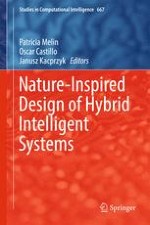2017 | OriginalPaper | Buchkapitel
Particle Swarm Optimization of the Fuzzy Integrators for Time Series Prediction Using Ensemble of IT2FNN Architectures
verfasst von : Jesus Soto, Patricia Melin, Oscar Castillo
Erschienen in: Nature-Inspired Design of Hybrid Intelligent Systems
Aktivieren Sie unsere intelligente Suche, um passende Fachinhalte oder Patente zu finden.
Wählen Sie Textabschnitte aus um mit Künstlicher Intelligenz passenden Patente zu finden. powered by
Markieren Sie Textabschnitte, um KI-gestützt weitere passende Inhalte zu finden. powered by
